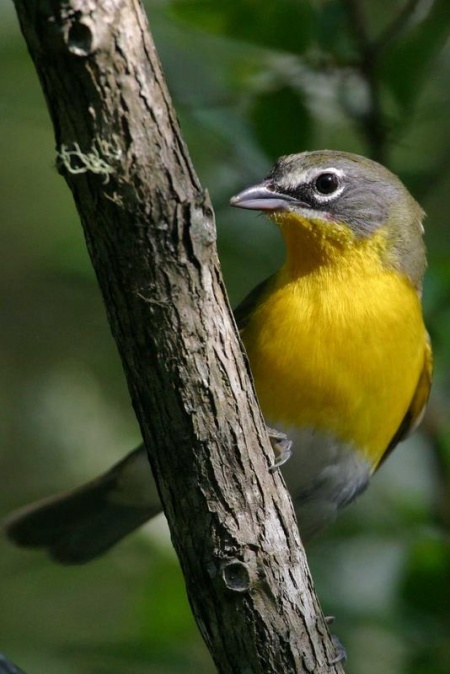(tax, range, ref, id) |
(User template. Subspecies. Attempt to disguise some copied text. Referenced) |
||
| Line 1: | Line 1: | ||
| − | [[Image:Yellow-breasted_Chat.jpg|thumb|450px|right|Photo by Vogelman<br /> | + | [[Image:Yellow-breasted_Chat.jpg|thumb|450px|right|Photo by {{user|Vogelman|Vogelman}}<br />High Island, [[Texas]], [[USA]]]] |
;[[:Category:Icteria|Icteria]] virens | ;[[:Category:Icteria|Icteria]] virens | ||
| − | |||
==Identification== | ==Identification== | ||
| − | 19cm | + | 19cm<br /> |
| − | + | Olive upperparts, white belly, yellow throat and breast, long tail, thick heavy bill, large white eye-ring, and dark legs. | |
==Distribution== | ==Distribution== | ||
Breeds in [[USA]], western half of southern [[Canada]] and northern [[Mexico]]. Recent results suggest that at least part of the US population after having bred in early parts of summer migrates to north-western Mexico where a second round of breeding takes place before the birds go on the final migration to their winter home. | Breeds in [[USA]], western half of southern [[Canada]] and northern [[Mexico]]. Recent results suggest that at least part of the US population after having bred in early parts of summer migrates to north-western Mexico where a second round of breeding takes place before the birds go on the final migration to their winter home. | ||
| Line 10: | Line 9: | ||
In winter found in Mexico (mostly southern half) though [[Central America]] to [[Panama]]. | In winter found in Mexico (mostly southern half) though [[Central America]] to [[Panama]]. | ||
==Taxonomy== | ==Taxonomy== | ||
| + | ====Subspecies<sup>[[#References|[1]]]</sup>==== | ||
Two subspecies are recognized: | Two subspecies are recognized: | ||
| − | *''virens'' | + | *''I. v. virens'': Eastern |
| − | *''auricollis'' | + | :*North-central and eastern [[US]] to [[Florida]]; winters to [[Panama]] |
| − | + | *''I. v. auricollis'': Western | |
| + | :*Southern [[British Columbia]] to Baja and northern [[Mexico]]; winters to [[Guatemala]] | ||
==Habitat== | ==Habitat== | ||
| − | Dense | + | Dense brush and hedgerows. |
| − | |||
==Behaviour== | ==Behaviour== | ||
| − | The | + | ====Breeding==== |
| − | + | The cup-shaped nest is hidden in thick shrubs. | |
| + | ====Diet==== | ||
The diet includes insects and berries. | The diet includes insects and berries. | ||
==References== | ==References== | ||
| − | # | + | #{{Ref-Clements6thDec09}}#[http://www.pnas.org/content/early/2009/10/23/0908121106.full.pdf+html?sid=8b8b4693-427c-44f1-bc91-c5e033220adc Paper] describing migration to second breeding area |
| − | # [http://www.pnas.org/content/early/2009/10/23/0908121106.full.pdf+html?sid=8b8b4693-427c-44f1-bc91-c5e033220adc Paper] describing migration to second breeding area | + | #Wikipedia |
{{ref}} | {{ref}} | ||
==External Links== | ==External Links== | ||
Revision as of 22:56, 12 May 2010
- Icteria virens
Identification
19cm
Olive upperparts, white belly, yellow throat and breast, long tail, thick heavy bill, large white eye-ring, and dark legs.
Distribution
Breeds in USA, western half of southern Canada and northern Mexico. Recent results suggest that at least part of the US population after having bred in early parts of summer migrates to north-western Mexico where a second round of breeding takes place before the birds go on the final migration to their winter home.
In winter found in Mexico (mostly southern half) though Central America to Panama.
Taxonomy
Subspecies[1]
Two subspecies are recognized:
- I. v. virens: Eastern
- I. v. auricollis: Western
- Southern British Columbia to Baja and northern Mexico; winters to Guatemala
Habitat
Dense brush and hedgerows.
Behaviour
Breeding
The cup-shaped nest is hidden in thick shrubs.
Diet
The diet includes insects and berries.
References
- Clements, JF. 2009. The Clements Checklist of Birds of the World. 6th ed., with updates to December 2009. Ithaca: Cornell Univ. Press. ISBN 978-0801445019.
- Paper describing migration to second breeding area
- Wikipedia
Recommended Citation
- BirdForum Opus contributors. (2024) Yellow-breasted Chat. In: BirdForum, the forum for wild birds and birding. Retrieved 27 September 2024 from https://www.birdforum.net/opus/Yellow-breasted_Chat




